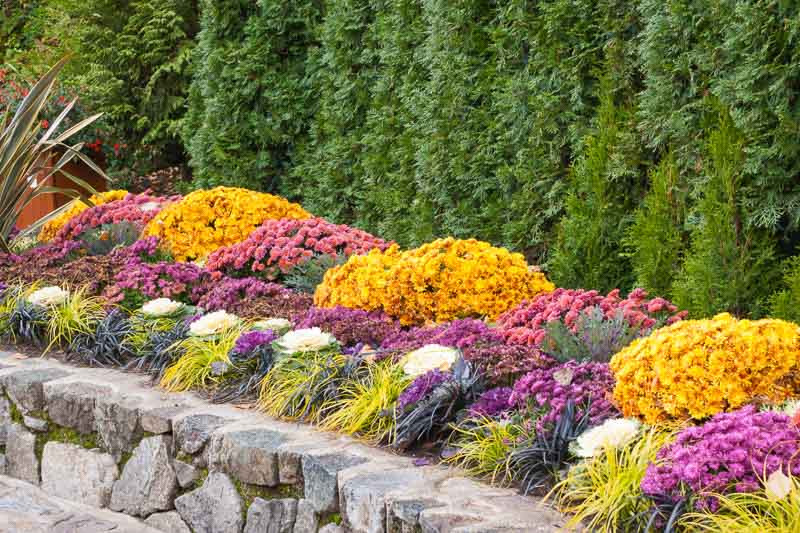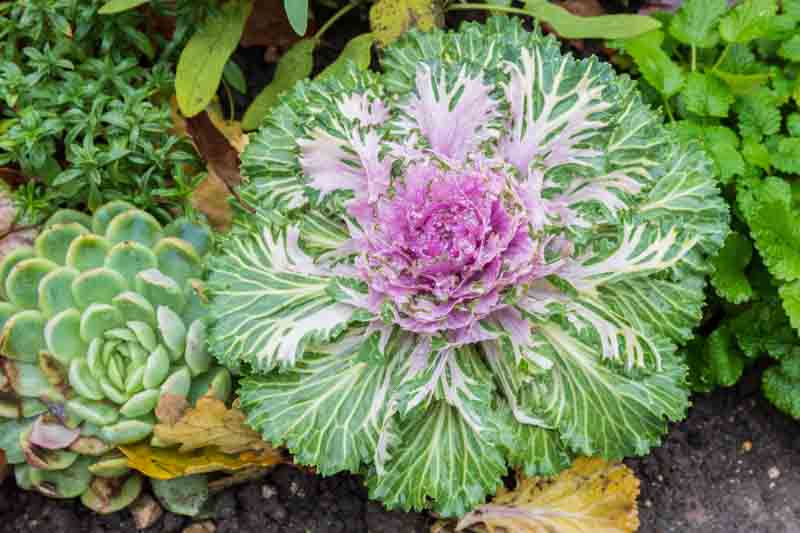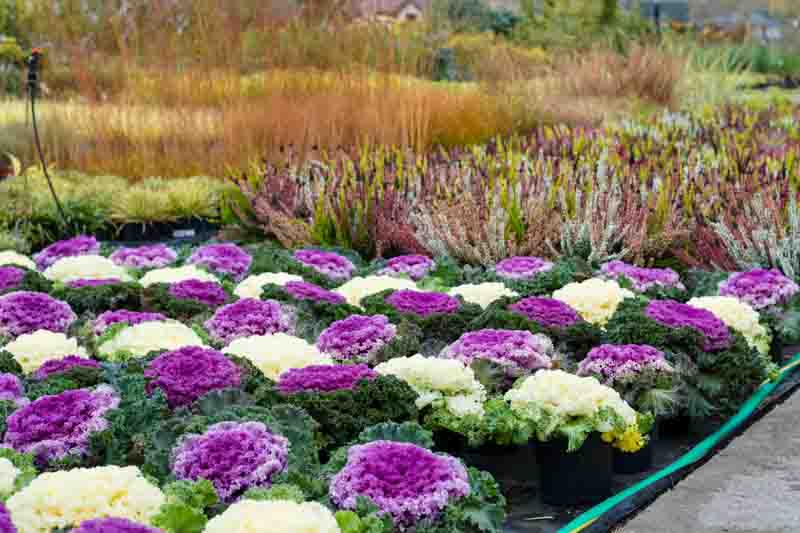Ornamental Kale, Ornamental Cabbage, Flowering Kale, Flowering Cabbage
Ornamental kale and cabbage are celebrated for their exceptional beauty in cool weather, easy care, and versatility in garden design. Their robust colors and unique forms make them favorites for gardeners looking to extend the gardening season well into the colder months. Whether used in mass plantings, as edging, or as dramatic container specimens, these ornamentals provide a striking visual impact with minimal effort.
Ornamental kale and cabbage are varieties of Brassica oleracea var. acephala, cultivated not for consumption but for their aesthetic appeal. These plants are grown primarily for their visually striking leaves, which come in shades of purple, pink, green, and white. They belong to the Brassicaceae family, including cabbage, broccoli, and cauliflower. Unlike their vegetable counterparts, ornamental kale and cabbage feature leaves that can be frilly or ruffled and become more intensely colored with cooler weather.
Description: Ornamental kale and cabbage feature rosettes of curly or smooth leaves in shades of purple, pink, white, and green. The color intensifies as the weather cools, making them standout additions to the winter landscape.
Growth habit: They are biennial plants treated as annuals in most gardens. They exhibit a compact, rosette growth habit with leaves that can be frilly or smooth-edged.
Size: Typically, they grow 12-18 inches (30-45 cm) tall and wide, forming dense, low rosettes that spread outwards.
Flowers: Though grown for their foliage, they can produce yellow flowers in their second year before setting seed.
Foliage: The true allure lies in their leaves, which are large, often crinkled, and come in a variety of colors. The cooler the temperature, the more vibrant the foliage becomes.
Hardiness: They are hardy in USDA zones 2-11 as cool-season plants, thriving in the cooler temperatures of fall and early winter.
Uses: Ornamental kale and cabbage are popular additions to fall and winter gardens, providing a vibrant splash of color when most other plants have ceased blooming or have died back. They are used in landscaping for their unique textures and hues, in container gardens for seasonal interest, and even in floral arrangements. While edible, they are typically more bitter than culinary varieties and are usually grown for decorative purposes. They combine nicely with chrysanthemums, asters, coral bells, or sedges.
Toxicity: Kale is non-toxic to humans and is safe for consumption. However, it contains compounds called glucosinolates, which can be toxic to some animals, such as livestock, when consumed in large quantities.
 Ornamental Kale and Chrysanthemum
Ornamental Kale and Chrysanthemum
Growing and caring for ornamental kale and cabbage is straightforward, making them excellent choices for adding color to fall and winter gardens. Here are some tips on how to grow and care for these vibrant plants:

Like other brassica family members, Ornamental kale and cabbag are susceptible to several pests and diseases.
Aphids: These tiny insects suck the sap from the leaves, causing yellowing and curling. They can also transmit viruses. Control aphids by spraying with insecticidal soap, neem oil, or introducing beneficial insects like ladybugs.
Cabbage loopers: These green caterpillars feed on the leaves, creating holes and damaging the plant. Handpick them from the plants or use a biological control like Bacillus thuringiensis (Bt), a naturally occurring soil bacterium that targets caterpillars.
Cabbage worms: Small green caterpillars that feed on the leaves, causing holes and damage. Similar to cabbage loopers, control them with handpicking or using Bt.
Slugs and Snails: These pests feed on the leaves during the night, leaving large irregular holes. Use beer traps, handpicking, copper tape, or diatomaceous earth to control their population.
Downy mildew: A fungal disease that causes yellow spots on the upper leaf surface and a white, fuzzy growth on the underside. Improve air circulation, reduce leaf wetness, and apply a fungicide labeled for downy mildew control if needed.
Powdery mildew: A fungal disease that causes a white, powdery growth on the leaves. Increase air circulation, reduce leaf wetness, and apply a fungicide labeled for powdery mildew control if needed.

Ornamental cabbage and kale typically last until the weather becomes too warm. In cooler climates, they can maintain their color and form from fall through late winter or early spring. Their longevity is temperature-dependent; they start to decline as average temperatures rise above 60°F (15°C).
The best place to plant ornamental kale is in a location that receives full sun to partial shade. They thrive in well-drained, fertile soil. They are perfect for garden beds, borders, and containers where their vibrant colors can be fully appreciated.
Ornamental cabbage pairs well with a variety of plants, including: pansies and violas, mums (Chrysanthemum), dusty miller, coral bells (Heuchera), asters and evergreen shrubs.
Ornamental cabbage and kale are typically grown as annuals, meaning they complete their life cycle in one season and do not come back every year. However, they can self-seed under the right conditions, potentially emerging again in the garden.
Ornamental kale is not suited to survive through hot summer conditions. These plants are cool-season biennials, treated as annuals in gardening, and tend to bolt (flower and set seed) as temperatures rise. They perform best in cool weather and usually decline once the heat of summer sets in.
| Hardiness |
2 - 11 |
|---|---|
| Climate Zones | 1, 1A, 1B, 2, 2A, 2B, 3, 3A, 3B, 4, 5, 6, 7, 8, 9, 10, 11, 12, 13, 14, 15, 16, 17, 18, 19, 20, 21, 22, 23, 24, A1, A2, A3, H1, H2 |
| Plant Type | Annuals |
| Plant Family | Brassicaceae |
| Exposure | Full Sun |
| Season of Interest |
Spring (Early) Fall Winter |
| Height |
1' - 2' (30cm - 60cm) |
| Spread |
1' - 2' (30cm - 60cm) |
| Spacing |
12" - 18" (30cm - 50cm) |
| Maintenance | Low |
| Water Needs | Average |
| Soil Type | Chalk, Clay, Loam, Sand |
| Soil pH | Alkaline, Neutral |
| Soil Drainage | Moist but Well-Drained, Well-Drained |
| Hardiness |
2 - 11 |
|---|---|
| Climate Zones | 1, 1A, 1B, 2, 2A, 2B, 3, 3A, 3B, 4, 5, 6, 7, 8, 9, 10, 11, 12, 13, 14, 15, 16, 17, 18, 19, 20, 21, 22, 23, 24, A1, A2, A3, H1, H2 |
| Plant Type | Annuals |
| Plant Family | Brassicaceae |
| Exposure | Full Sun |
| Season of Interest |
Spring (Early) Fall Winter |
| Height |
1' - 2' (30cm - 60cm) |
| Spread |
1' - 2' (30cm - 60cm) |
| Spacing |
12" - 18" (30cm - 50cm) |
| Maintenance | Low |
| Water Needs | Average |
| Soil Type | Chalk, Clay, Loam, Sand |
| Soil pH | Alkaline, Neutral |
| Soil Drainage | Moist but Well-Drained, Well-Drained |
How many Ornamental Kale and Cabbage (Brassica oleracea) do I need for my garden?
| Plant | Quantity | |
|---|---|---|
| Ornamental Kale and Cabbage (Brassica oleracea) | N/A | Buy Plants |
Create a membership account to save your garden designs and to view them on any device.
Becoming a contributing member of Gardenia is easy and can be done in just a few minutes. If you provide us with your name, email address and the payment of a modest $25 annual membership fee, you will become a full member, enabling you to design and save up to 25 of your garden design ideas.
Join now and start creating your dream garden!
Create a membership account to save your garden designs and to view them on any device.
Becoming a contributing member of Gardenia is easy and can be done in just a few minutes. If you provide us with your name, email address and the payment of a modest $25 annual membership fee, you will become a full member, enabling you to design and save up to 25 of your garden design ideas.
Join now and start creating your dream garden!